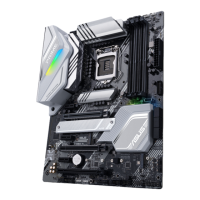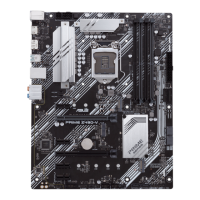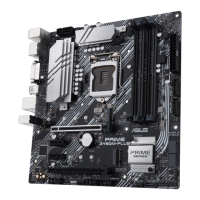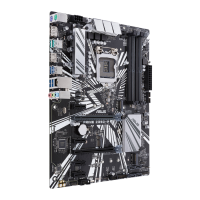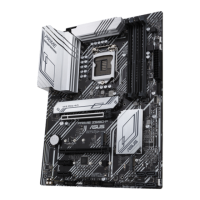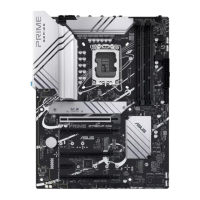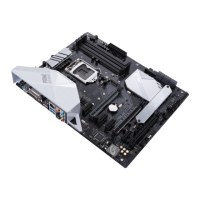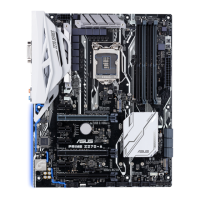Do you have a question about the Asus PRIME Z490-P and is the answer not in the manual?
Precautions to prevent electrical shock hazard when handling the system and its components.
Guidelines for safe operation and handling of the motherboard and system components.
Describes the structure and content of the user guide, including chapters and their topics.
Lists resources for additional information and product/software updates, including the ASUS website.
Explains the meaning of symbols (CAUTION, IMPORTANT, NOTE) used throughout the manual.
Details CPU socket compatibility, supported Intel processors, and Turbo Boost technologies.
Specifies the Intel Z490 Chipset used on the motherboard.
Outlines memory type, maximum capacity, supported speeds, and architecture.
Lists supported graphics outputs and specifications.
Details the types and configurations of PCIe slots available on the motherboard.
Mentions support for AMD CrossFireX™ technology.
Describes M.2 slots and SATA ports, including RAID support.
Specifies the Ethernet controller and speed.
Mentions the M.2 slot for Wi-Fi module.
Details the number and types of USB ports on the rear and front panels.
Describes the audio codec and its features.
Lists all connectors on the motherboard's rear I/O panel.
Lists various internal connectors for fans, power, storage, and USB.
Lists various headers like Aura RGB, Clear CMOS, COM, etc.
Highlights ASUS-specific features like 5X Protection III, Q-Design, and Thermal Solution.
Lists ASUS software utilities such as Armoury Crate and Aura Sync.
Lists general software features and utilities.
Lists BIOS utilities and modes.
Specifies BIOS type and size.
Lists manageability features like WOL and PXE.
Mentions supported operating systems.
States the motherboard form factor and dimensions.
Details bandwidth sharing between M.2 slots and SATA ports.
Provides essential precautions for installing motherboard components to prevent damage.
Illustrates the physical layout of the motherboard and its key components.
Details the LGA1200 socket, installation precautions, and warranty information.
Describes the DDR4 DIMM sockets and compatibility warnings.
Shows diagrams for installing memory modules in dual-channel configurations.
Explains memory installation guidelines, channel mapping, and QVL.
Details the PCIe slots and recommended VGA configurations.
Provides guidance on using single and dual VGA configurations with PCIe slots.
Explains how to configure the Hyper M.2 X16 series card.
Describes the fan and pump headers, their specifications, and connection guidelines.
Details the ATX power connectors and PSU recommendations.
Explains the M.2 slots and their compatibility with M.2 SSD modules.
Describes the SATA ports and their usage for storage devices and RAID.
Explains the USB 3.2 Gen 1 headers for connecting additional ports.
Describes the USB 2.0 headers for connecting additional ports.
Details the header for addressable RGB LED strips and its specifications.
Explains the RGB headers for connecting standard RGB LED strips.
Describes the header for clearing CMOS settings and the procedure.
Explains the serial COM port header for connecting a serial module.
Describes the header for connecting the front panel audio module.
Details the M.2 slot for installing Wi-Fi modules.
Explains the header for Trusted Platform Module (TPM) systems.
Describes the header for chassis-mounted functions like power LEDs and buttons.
Explains the header for connecting an add-on Thunderbolt I/O card.
Introduces the section on assembling the PC system and its components.
Provides step-by-step instructions for installing the CPU into the socket.
Details the installation process for CPU heatsink and fan assemblies.
Explains how to install and remove memory modules (DIMMs).
Illustrates the steps for installing an M.2 SSD module.
Guides on installing the motherboard into the PC chassis and securing it.
Details how to connect the ATX power supply cables to the motherboard.
Shows how to connect SATA devices like hard drives and optical drives.
Explains connections for front panel headers like USB and audio.
Guides on installing PCIe x16 and PCIe x1 expansion cards.
Guides on initial system startup, POST, and BIOS beep codes.
Explains how to properly turn off or put the system into sleep/soft-off mode.
Illustrates and lists the connectors on the motherboard's rear panel.
Explains the status and speed LEDs for the Ethernet port.
Details audio jack configurations for different channel setups.
Shows how to connect audio devices like headphones and microphones.
Introduces the ASUS UEFI BIOS and its function in storing system settings.
Explains how to enter the BIOS setup program and general usage tips.
Details the utility for updating the BIOS using a USB drive.
Describes the utility for recovering a corrupted BIOS.
Explains different RAID levels (0, 1, 5, 10) supported by the motherboard.
Contains FCC compliance information and regulatory statements.
Provides contact details for ASUS technical support and customer service.
| Cables included | SATA |
|---|---|
| CPU fan connector | Yes |
| Thunderbolt headers | 1 |
| Number of SATA III connectors | 4 |
| USB 3.2 Gen 1 (3.1 Gen 1) connectors | 2 |
| USB 3.2 Gen 2 (3.1 Gen 2) connectors | 0 |
| BIOS type | UEFI AMI |
| BIOS memory size | 128 Mbit |
| HDMI version | 1.4b |
| DisplayPort version | 1.4 |
| USB 2.0 ports quantity | USB 2.0 ports have a data transmission speed of 480 Mbps, and are backwards compatible with USB 1.1 ports. You can connect all kinds of peripheral devices to them. |
| Audio chip | Realtek ALC887 |
| Component for | PC |
| Motherboard chipset | Intel Z490 |
| Audio output channels | 8 channels |
| Motherboard form factor | ATX |
| Motherboard chipset family | Intel |
| Wi-Fi | No |
| LAN controller | Realtek RTL8111H |
| Ethernet interface type | Gigabit Ethernet |
| RAID levels | 0, 1, 5, 10 |
| Supported storage drive types | HDD & SSD |
| Supported storage drive interfaces | M.2, SATA III |
| Maximum resolution | 4096 x 2304 pixels |
| Parallel processing technology support | 2-Way CrossFireX |
| Memory channels | Dual-channel |
| Memory slots type | DIMM |
| Supported memory types | DDR4-SDRAM |
| Maximum internal memory | 128 GB |
| Supported memory clock speeds | 2133, 2400, 2666, 2800, 2933, 3000, 3200, 3300, 3333, 3400, 3466, 3600, 3733, 3866, 4000, 4133, 4266, 4400, 4500, 4600 MHz |
| Processor socket | LGA 1200 (Socket H5) |
| Compatible processor series | Intel Celeron, Intel Core i3, Intel Core i5, Intel Core i7, Intel Core i9, Intel Pentium |
| Depth | 234 mm |
|---|---|
| Width | 305 mm |
